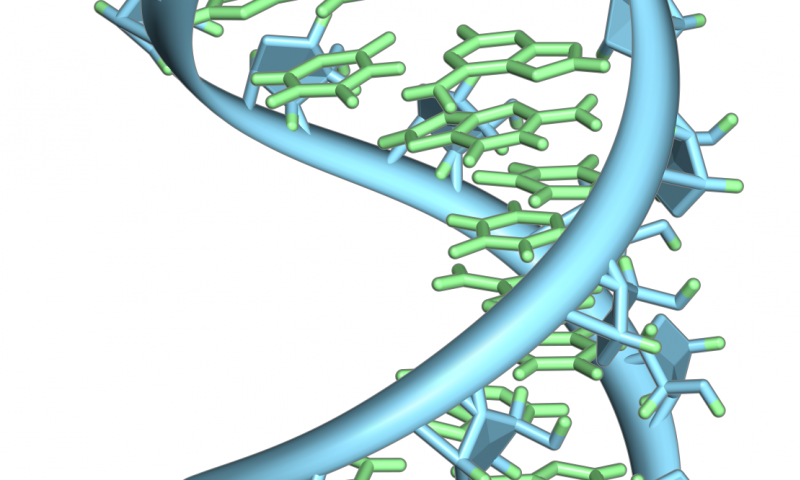‘The RNA World’ Hypothesis for Origin of Life May Not Be Sufficient

Representational image. | Image Courtesy: Science Daily
What could have happened four billion years ago when life started to emerge? The one dominant idea has been the “RNA World Hypothesis”—which says that RNA appeared to be the first living substance. The concept emanated from the understanding that non-living chemicals could not have given rise to bacterial cells only in a single step, which, therefore suggests that, some pre-cellular life forms must have existed. The most popular model of the pre-cellular life form is the RNA World.
The underlying reason of the hypothesis is that RNA is capable of self replication and therefore is able to carry forward genetic information across generations. The RNA could also act like an enzyme, which is the characteristic of proteins. Thus, RNA is thought to be the molecule that could perform the basic functions of life forms, and is the primitive life molecule. Later on, evolution makes DNA to be the prevalent genetic molecule to pass the information for life from generation to generation.
But recent researches have come out with findings which suggest that things may not be as simple as imagined in the “RNA World” idea with the latest one appearing in Nature Chemistry on April 1. This study suggests that the most primitive living things may have used both RNA and DNA molecules as all the modern cells do. Ramanarayan Krishnamurthy, the co-principal investigator of the study, quoted to have said to Science Daily—“These new findings suggest that it may not be reasonable for chemists to be so heavily guided by the RNA World hypothesis in investigating the origins of life on Earth.”
Krishnamurthy belongs to Scripps Institute and collaborated with John Sutherland, Laboratory of Molecular Biology, Cambridge as a part of the New York-based Simon Foundation’s Collaboration on the Origin of Life.
The RNA (ribonucleic acid) and the DNA (deoxyribonucleic acid) molecules are similar chemically. Nevertheless, chemists have never been able to find out the clue how one molecule could have got converted into the other during the early period of emergence of life forms. The only possibility was the conversion being carried by some enzymes produced by early organisms. Due to the lack of the clue that could link RNA to DNA, scientists have been inclined to accept the RNA World hypothesis. RNA is able to store genetic information like the DNA, is able to catalyse biochemical reactions similarly as the proteins (enzymes), and was probably the molecule that performed tasks necessary for the survival of lives.
Most of the origin-of-life researchers have accepted the RNA World idea, but Sutherland, Krishnamurthy and others have accumulated evidence that RNA and DNA could have arisen more or less at same time in the first life forms.
In the year 2017, Krishnamurthy’s team at Scripps Institute identified a compound that was possibly present in the pre-biotic period, and could have performed the task of linking RNA building blocks into chain like RNA strands. This compound could have also done the linking of DNA building blocks into larger DNA strands.
The latest Nature Chemistry paper was a result of a joint study of Krishnamurthy’s team and Sutherland’s team that combined Krishnamurthy’s 2017 finding with the work of Sutherland’s lab on another compound called thiouridine. This compound is supposed to be present on the earth before life arose and could be a precursor of nucleoside building blocks of RNA. They showed that this RNA building block could be converted to DNA building block—the deoxyadenosine (denoted by the letter A) in a few chemical reactions which possibly could have occurred in a pre-biotic world. Also, they could convert thiouridine into deoxyribose—a closely related entity to deoxyadenosine and might have functioned as a precursor of early DNA building blocks.
Sutherland and some other researchers have also suggested that the first gene might have formed by a mixture of DNA and RNA. Till date, no such organism is known to occur naturally, but a recent paper by Peter Schultz and colleagues reported a bacterium that they engineered in the lab could survive with genes made up from RNA/DNA mixture.
This new line of evidence is making scientist rethink about the RNA World hypothesis and accepting the possibility of simultaneous appearance of RNA and DNA in early lives. With time, the DNA and RNA were segregated in terms of their specialised functions—DNA for the stable long-term storage of genetic information and RNA for its many specialised tasks from making of proteins to short term storage of genetic information.
Also read: Ancient DNA Analyses Reveal New Facts About Human Migration and Survival Around Ice Age
Get the latest reports & analysis with people's perspective on Protests, movements & deep analytical videos, discussions of the current affairs in your Telegram app. Subscribe to NewsClick's Telegram channel & get Real-Time updates on stories, as they get published on our website.














